Karnataka 2nd PUC Biology Notes Chapter 1 Reproduction in Organisms
→ Reproduction is one of the important characteristics of life. It is defined as a biological process in which an organism give rise to young ones (offsprings) similar to itself. The off-springs grow, mature and in turn produce new offsprings. Thus, there is a cycle of birth, growth and death. Reproduction is necessary for the continuation of life and to compensate for the loss of life due to death.
→ Each organism has evolved its own mechanism to multiply and produce offsprings. The reproduction is of two types – asexual and sexual. When an offspring is produced by a single parent without the formation and fusion of gametes, then the reproduction is called asexual, when two parents (of the opposite sex) or a bisexual organism participate in the reproductive process and involve fusion of male and female gametes, then it is called sexual reproduction.
Asexual Reproduction
The production of offsprings by single parent without the formation and fusion of gametes is called asexual reproduction. It is also known as agamogenesis or agamogeny.
The offsprings produced by sexual reproduction are identical and are also exact copies of their parents. A group of genetically identical offsprings produced from a single parent are called clone.
Note: However, members of a clone may differ genetically when there is mutation (a sudden heritable change).
![]()
Characteristics of Asexual reproduction
- A single parent is involved (uniparental condition).
- Gametes are not formed.
- No fertilization.
- There is only mitotic cell division.
- Daughter organisms are genetically identical to the parent.
- Multiplication occurs rapidly.
Asexual reproduction takes place in the following ways;
1. Binary Fission: In this process the parent organism divides into two halves, each half forms one independent daughter organism. Binary fission involves mitosis. Binary fission occurs in Amoeba – simple binary fission, Euglena and Vorticella – longitudinal binary fission, Paramoecium and Planaria-transverse binary fission, Ceratium – oblique binary fission.

2. Multiple Fission: In this process, the parent body divides into many daughter organisms. Multiple fission occurs in amoeba, plasmodium, monocystis (all protozoans).
3. Encystation & Sporulation: Under unfavourable conditions amoeba withdraws its pseudopodia and secretes a three layered hard covering or cyst around itself. This phenomenon is termed as encystation. When the favourable conditions return, the encysted amoeba divides by multiple fission and produces many pseudopodiospores. Finally by the breakdown of cyst wall the spores are liberated into the surrounding medium to grow up into many amoebae. This phenomenon is known as sporulation.
4. Exogenous Budding: In this process, a daughter organism is formed from a small projection, the bud, arising from the parent body. An outgrowth or bud grows externally on the surface of the body. The bud may split away from the parent and take up an independent existence as in Hydra or it may remain attached and become a more or less independent member of the colony as in Sycon.
In yeast, the cell division is unequal and results in a large cell and a small cell, called bud which remains attached to the large cell; the bud gets separated and grows into an adult yeast.
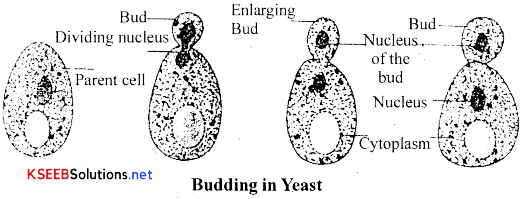
![]()
5. Gemmule Formation: In fresh water sponges (e.g., spongilia) and a few marine sponges (except in Sycon), buds are formed within the parents body. They are called gemmules
(= internal buds).
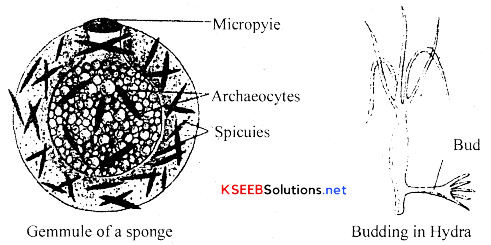
6. Zoospores: The members of the Kingdom Fungi and simple plants such as algae (e.g., Chlamydomonas) reproduce through special motile reproductive structures called zoospores)
7. Conidia formation : Conidia are produced by Penicillium, Aspergillus, etc., are non-motile. Conidia are exogenous outgrowths borne on the tip of special hyphae called conidio phores.
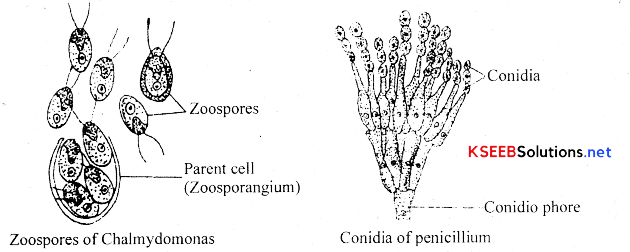
Vegetative Propagation
In plants, the term vegetative propagation is frequently used to explain asexual reproduction.
Note: Besides the natural methods of vegetative propagation, human beings have developed several techniques for artificial vegetative propagation’of economic plants.
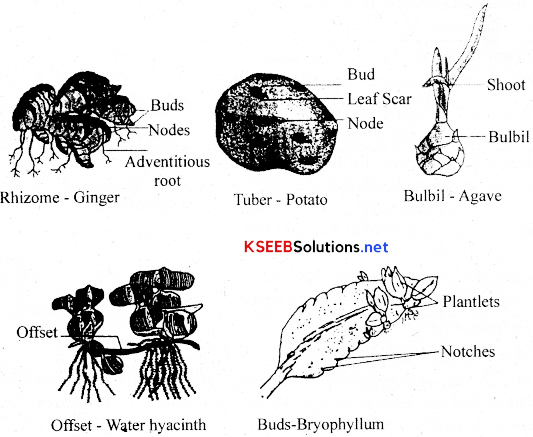
![]()
Natural Vegetative Propagation
A number of perennial plants propagate vegetatively in nature. Different vegetative parts such as roots, stems and leaves are variously modified to help in vegetative propagation in these plants.
1. Vegetative propagation by roots: The intact roots of many woody plants (such as Murraya sp., Albizia lebbek, Guava, Dalbergia sissoo), which are growing just below the ground develop adventitious buds. The buds put out shoots and produce new plants.
The roots of plants like sweet potato, dahlia, asparagus, dioscoria (yam), tapioca etc., are tuberous and store abundant of food materials. They bear adventitious buds and provide a means of vegetative propagation. The buds present on the roots grow into leafy shoots called slips. The young slips are detached from parent plants and grow separately.
2. Vegetative propagation by stems: In many plants, stem is the source of natural vegetative propagation.
It is of various types-Sub-aerial or creeping stems like runners (e.g., Cyndron – lawn grass), suckers (e.g., mint chrysanthemum), stolons (e.g., Fragaria – strawberry), offset (Eichhoria – water hyacinth) produce new shoots or crowns, which may break and give rise to independent plants.
Underground stems like rhizomes (e.g., ginger, turmeric, banana etc.), corms (colocasia, gladious, freesia, crocus etc.), bulbs (onion, garlic, narcissus etc.) and tubers (e.g., potato, artichoke etc.) possess buds to form new plants. Due to mechanical force or natural decay of older parts, underground stems may give rise to independent plants.
Stem segment of some aerial shoots such as opuntia, cacti etc., develops into new plants after falling on the ground.
Nice to know: Water hyacinth is an aquatic plant and is one of the most invasive weeds growing in standing waters. It is popularly known as ‘terror of Bengal’.
It drains oxygen from the water which leads to death of fishes. It can propagate vegetatively at a phenomenal rate and spread all over the water body in a short period of time.
3. Vegetative propagation by leaves : Leaves are not a common mean of vegetative propagation in nature. In Bryophyllum diagremontianum, plantlets develop from the buds present on the marginal notches of the intact leaves. These plantlgts become detached arid develop into independent plants. On other species of Bryophyllum and Kalanchoe, new plants arise only when leaf is injured or detached.
4. Vegetative propagation through bulbils: Bulbils are fleshy buds, which develop into new plants after falling on the ground, e.g., Dioscorea, oxalis, pineapple.
Artificial Vegetative Propagation
In addition to the natural methods of vegetative propagation as described above, several artificial methods of vegetative propagation are practiced. Following are the importapt artificial methods of vegetative propagation:
1. Cutting: ‘The division of a portion of any plant organ such as stem, root or leaf used for vegetative propagation is called cutting. Stem cuttings are most commonly used for this purpose.
e.g. Sugarcane, grapes, cocoa, rose, bougainvillea, duranta and carnations etc.
Note: Stem cutting of some plants do not produce roots readily and have to be treated with a root promoting hormone such as IBA and NAA etc.
2. Layering: In this method of vegetative propagation, roots are induced on a stem branch, before it is detached from the parent plant for propagation. Once the roots are induced, the branch is detached from the main plant and transplanted to the desired place.
3. Grafting: It is a method of joining two different plants, so as to make them grow as one composite unit. Here, a twig from one plant is transplanted to a rooted plant of a different variety, of the same species. This brings organic connection between the two, bringing in best qualities of both. The branch that is inserted is known as graft or scion and the plant that is rooted to the soil is called stock.
![]()
Importance of vegetative propagation:
Vegetative propagation has a number of advantages. Some of these are as follows.
1. Vegetative propagation is the only known method of multiplication in plants like banana,
seedless grapes and oranges, rose and jasmine that have lost their capacity to produce seeds through sexual reproduction.
2. Plants like bermuda grass or doob grass (Cynodoridactylon), which produce only a small quantity of seeds are mostly propagated vegetatively.
3. Vegetative propagation is a more rapid, easier and a less expensive method of multiplying plants which have either poor seed viability or prolonged seed dormancy.
4. It also helps us to introduce plants in new areas where seed germination fails to produce plants due to change in the soil and environmental conditions.
5. The greatest advantage of vegetative propagation is that all plants produced will have the same characters and hereditaiy potential as the parent plants. It is not possible in the plants raised from seeds, since they contain blended characters of both the parents.
6. Grafting permits the physical and physiological joining of separate individuals for the best economic advantage i.e., good qualities of two varieties can be combined in one composite plant.
7. The good qualities of a race or variety can be preserved indefinitely.
Sexual Reproduction
Sexual reproduction involves formation of the male and female gametes either by the same individual or by different individuals of the opposite sex. These gametes fuse to form the zygote which develops to form the new organism. Because of the fusion of male and female gametes, sexual reproduction results in offsprings that are not identical to the.parents or amongst themselves. Sexual reproduction is an elaborate, complex and slow process.
![]()
Note:
1. If both the male and female reproductive organs are present in the same individual then the condition is called monoecious and if present in separate individuals the condition is known as dioecious.
Sexual reproduction involves meiosis or reductional division during the formation of gametes.
2. Differences between asexual and sexual reproduction
| Asexual reproduction | Sexual reproduction |
| 1. Always uniparental. | 1. Can be biparental or uniparental. |
| 2. Occurs by zoospores, conidia, budding, fragmentation etc. | 2. Occurs by the fusion of haploid gametes |
| 3. Offsprings are genetically identical to the parents. | 3. Offsprings differ among themselves and from the parents. |
| 4. It is a faster process. | 4. It is a slow process. |
Similarities in pattern of sexual reproduction:
Although the diverse organisms (i.e., plants, animals to fungi, differ in external morphology, internal structure and physiology, they show more or less similar pattern of sexual reproduction.
1. Juvenile/vegetative Phase: All organisms have to reach a certain stage of growth and maturity in their life, before they can reproduce sexually. In animals, this period of growth is called the juvenile phase, while in plants it is known as vegetative phase.
2. Reproductive phase: The end of juvenile/vegetative phase is marked by the beginning of the next phase called reproductive phase.
In higher plants, the reproductive phase is marked by the onset of flowering.
In animals, the juvenile phase is followed by morphological and physiological changes prior to active reproductive behaviour. In several animals, including human beings, the reproductive maturity is marked by a number of changes that occur in their bodies.
3. Flowering/breeding seasons: There are some plants which flower throughout the year, while some others show seasonal flowering i.e., they flower during the same month year after year. A few plants exhibit unusual flowering phenomenon.
e.g: Bamboo species flower only once in their life time generally after 50-100 years. Strobilanthus kunthiana(neelakuranji) flowers once in 12 years.
Most animals do not breed throughout the year, instead they are seasonal breeders. For instance, birds living in nature lays eggs only seasonally.
During reproductive phase, the female of placental mammals exhibit cyclical changes in the ovarian and reproductive ducts.
In non-primate mammals like cows, sheep, rats, deers, dogs, tiger etc., the cyclic changes during reproductive phase is called oestrus cycle.
In primate mammals like monkeys, apes and human beings, the cyclic changes during reproductive phase is called menstrual cycle.
Many, mammals are seasonal breeders, while a few are continuous breeders
![]()
4. Senescence (Aging): After reproductive maturity, all organisms enter into a senescent phase. This phase is characterised by gradual decrease in functional activities and cellular breakdown leading to the death of the organism.
Events in sexual reproduction:
There is a regular sequence of the events of sexual reproduction. These sequential events may be grouped into three distinct stages – the pre-fertilization, fertilization and the post fertilization events.
Pre-fertilization events:
These are the events which occurs prior to the fusion of gametes. Pre-fertilization events include gametogenesis and gamete transfer.
1. Gametogenesis: Gametogenesis is the process by which male and female sex cells or gametes are formed. Gametes are haploid cells. In some algae, the two gametes are similar in appearance (morphology) and are Called homogametes (=isogametes),. Such gametes cannot bp distinguished into male and female gametes. However, in majority of sexually reproducing organisms the gametes formed are of two morphologically distinct types, called heterogametes. In such organisms, the male gamete is called the antherozoid or sperm and the female gamete is called the egg or ovum.
Sexuality in organisms: Organisms exhibit different strategies regarding their sexuality.
Plants may have both male and female reproductive structures in the same plant i.e. bisexual or homothallic or on different plants i.e., heterothallic or dioecious.
In flowering plants, the unisexual male flower is staminate i.e., bearing stamens, while female is pistillate bearing pistils.
e.g: Monoecious plants – cucurbits and coconuts
Dioecious plants – papaya and date palm.
In animals, bisexual animals are also known as hermaphrodites and unisexual animals are also known as homophrodites.
e.g: Hermaphrodite animals: Tapeworm, leech
Homophrodite animals: Cockroach
Several organisms belonging to monera, fungi, algae and bryophytes have haploid plant body but in organisms belonging to pteridophytes, gymnosperms, angiosperms andmost of the animals have diploid body.
In diploid organisms specialised cells called meiocytes undergo meiosis during gamete formation
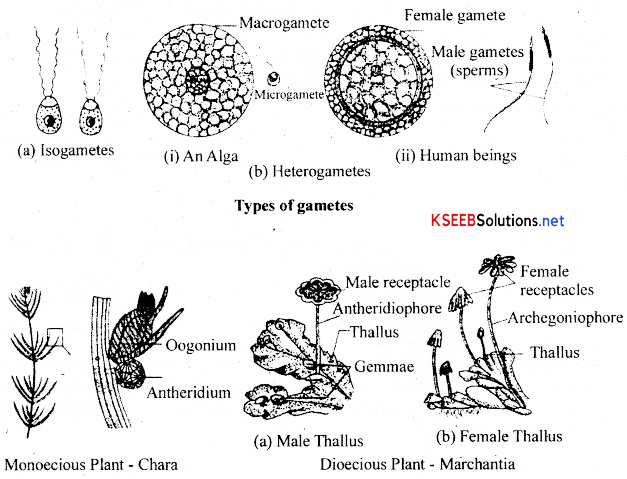
![]()
2. Gamete transfer: When the male and female gametes are formed, they are physically brought together so as to facilitate their fusion. In most of the organisms, the male gamete is motile, whereas the female gamete is hon-motile or stationary.
In several simple plants like algae, bryophytes and pteridophytes, water is the medium through which gamete transfer takes place.
In seed plants, pollen grains are the carries of male gametes and ovule have the egg. Pollen grains are transferred from the anthers on to the stigma by pollination.
Syngamy or Fertilization:
The fusion of gametes is called syngamy or fertilization. It results in the formation of a diploid zygote.
Parthenogenesis: It is interesting to note here that in some organisms, the female gametes develop into new organisms without fertilization. This phenomenon is termed as parthenogenesis (=virgin birth or virginal reproduction).
e.g., Rotifers (wheel animals), insects (e.g., honey bees, wasps, beetles, ants, aphids, grasshoppers)
Note: In liver fluke and some insects (e.g., gall fly), the larva produces a new generation of larvae by parthenogenesis. It is called paedogenetic parthenogenesis (Paedogenesis).
Site of Syngamy:
In many organisms which occur in aquatic habitats (e.g., algae, fishes and amphibians) syngamy occurs outside the body of the organism in the external medium i.e., in water. This type of gametic fusion is called external fertilization.
In most of the terrestrial organisms such as fungi, higher animals (such as reptiles, birds, mammals) and in a majority of plants (bryophytes, pteridophytes, gymnosperms and angiosperms). Syngamy occurs inside the body of the organism. This type of gametic fusion is called internal fertilization.
| External fertilisation | Internal fertilization |
| When fusion of gametes (syngamy) occurs outside the body of the organism, it is called external fertilisation. | When fusion of gametes (syngamy) occurs inside the body of the organism, it is called internal fertilisation. |
| A laige number of gametes are released in the surrounding medium by such animals e.g., bony fishes, amphibians, etc. | The number of ova produced is less, but a large number of male gametes are formed, as many of them fail to reach the ova. e.g., birds, mammals, earthworm, etc. |
| Wastage of gametes takes place due to water currents. | No wastage of gametes. |
![]()
Post-fertilization events:
The events in sexual reproduction that occur after the formation of zygote are called post-fertilization events.
1. The zygote: In all sexually reproducing organisms, a diploid zygote is produced as a result of fertilization. Later, the zygote produces a new individual.
2. Embryogenesis: The process of development of embryo from zygote is called embryogenesis. During this process, zygote undergoes cell division (mitotic divisions) and cell differentiation.
3. Post-fertilisation events:
1. All those events in sexual reproduction after the formation of zygote, are called post fertilisation events.
2. Zygote is the vital link, that ensures continuity of species between organisms of one generation and that ®f the next.
3. Development of zygote depends on,
- the type of life cycle of the organism and
- the environment it is exposed to.
4. In many algae and fungi, the zygote develops a thick wall around it and undergoes a period of rest during the unfavourable conditions, before germination at the return of favourable conditions.
5. In organisms showing haplontic life cycle, zygote undergoes meiosis, while in organisms showing diplontic or haplodiplontic life cycle,zygote undergoes mitosis.
6. The zygote develops into an embryo (embryogenesis).
7. Embryogenesis involves:
- Cell division to increase the number of cells.
- Cell enlargement or growth to increase the volume / weight of living matter.
- Cell differentiation, for the formation of different kinds of tissues.
8. Depending on whether the development of zygote occurs inside or outside the body of the female organism (parent), animals are categorized as oviparous and viviparous.
| Oviparous animals | Viviparous animals |
| These are the animals which lay fertilised or unfertilised eggs. | These are the animals which give birth to young individuals. |
| The fertilised eggs have a calcareous shell to protect them from the harsh environment. | The eggs have no calcareous shell, as they are protected inside the mother’s body. |
| Development occurs outside the body of the parent animal. | Development occurs inside the body of female parent. |
| Chances of survival are less. | Chances of survival are more. |
![]()
9. In flowering plants, the zygote is formed inside the ovule, where it develops into the embryo; simultaneously the ovule becomes the seed and the ovary becomes the fruit.
10. The seeds germinate after they are dispersed from the fruit and they produce new plants.